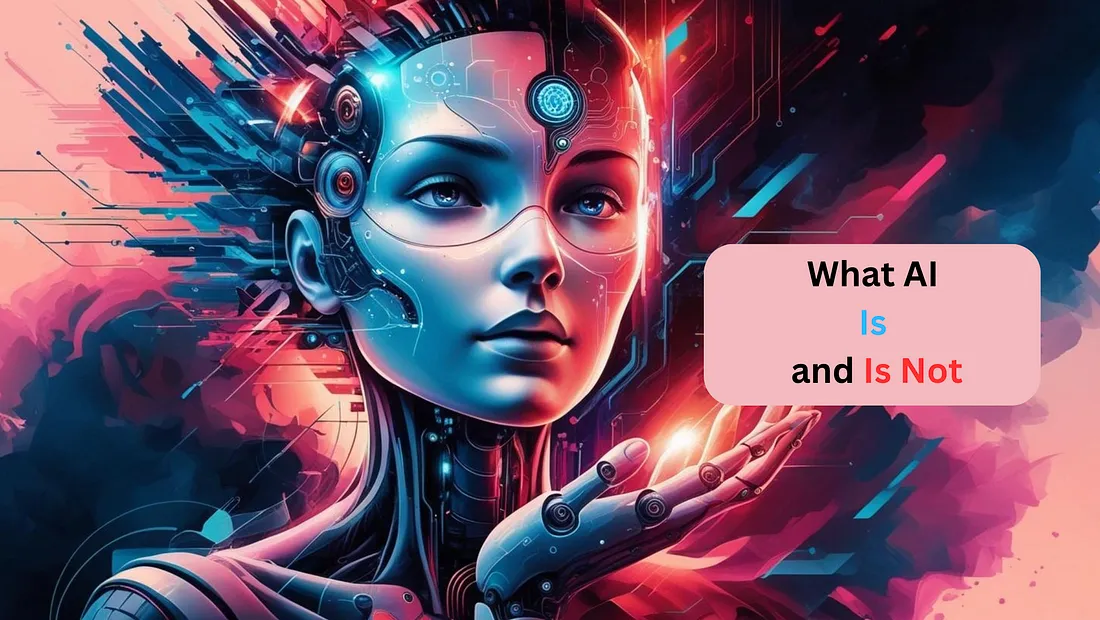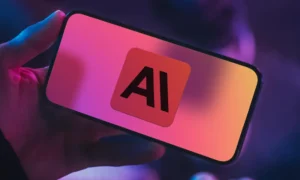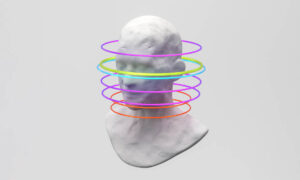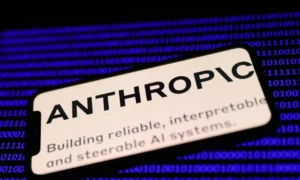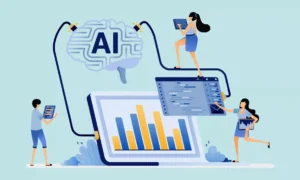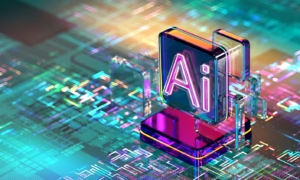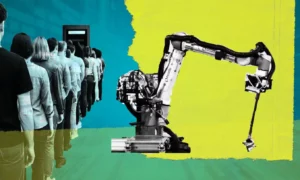Summary
- AI isn’t just tech hype — it’s reshaping how people work, create, and solve problems every day.
- Most people misunderstand what AI actually is and how it works (spoiler: it’s not magic or sentience).
- This guide breaks down AI types, history, real-world usage, ethical dilemmas, and what’s coming next.
- You’ll hear from experts, Reddit power users, and major institutions — with zero fluff and no hallucinated facts.
Introduction
AI gets talked about like it’s either humanity’s doom or salvation. One minute it’s helping a student pass their math exam; the next, it’s accused of stealing art or hallucinating fake court cases. With all the noise, it’s no wonder most people are confused about what AI really is — and what it actually does.
So let’s cut through the hype.
This article is your grounded, jargon-free walk through the fundamentals of AI — not just the definitions, but how it’s evolving, where it’s used, and what that means for you. It’s long, yes — but it’s packed with real examples, expert quotes, and insights from actual AI users. If you’re tired of marketing fluff or doom-posting, you’re in the right place.
Let’s dive in.
Understanding AI: From Definition to Classification
Artificial Intelligence (AI) refers to the development of computer systems that can perform tasks normally requiring human intelligence. These tasks include learning, reasoning, problem-solving, perception, and even language understanding. AI systems range from simple rule-based engines to complex models capable of natural language processing and image generation.
Importantly, AI is not one monolithic system. It’s a constellation of technologies — including machine learning, deep learning, and reinforcement learning — that all play different roles depending on the task.
Despite the recent buzz, the concept of AI dates back decades. But the models we interact with today — from ChatGPT to Midjourney — are the result of layered innovations across algorithms, hardware, and data.
What Most People Miss About AI’s Origins
AI didn’t begin with OpenAI or Google. It began with symbolic logic. The 1956 Dartmouth Conference is widely regarded as the birth of AI as a field. Early systems like ELIZA mimicked conversation using scripts — not understanding.
In the 1980s, expert systems were all the rage. Then came the neural network renaissance of the 2010s. Today, we see the rise of transformer-based models like GPT-4 and Gemini. But what’s often missed in this timeline is the role of hardware, data labeling, and public funding.
Also missing from many retrospectives? AI’s roots in military applications, early surveillance programs, and racial bias in training data. These buried legacies still influence how AI behaves — and who it benefits.
There are many ways to classify AI, but three foundational categories stand out:
- Narrow AI (ANI): Trained for one task — like image recognition or spam filtering. This is what powers most real-world tools today.
- General AI (AGI): A theoretical system with human-level cognitive abilities. It doesn’t exist yet.
- Superintelligent AI: A speculative concept where AI surpasses human intelligence in all areas. Often used in sci-fi or long-term ethics debates.
It’s also helpful to think in terms of capability maturity:
- Reactive Machines (like IBM’s Deep Blue)
- Limited Memory Systems (like self-driving cars)
- Theory of Mind AI (hypothetical)
- Self-Aware AI (purely speculative)
Each stage adds complexity — but also risk.
If you’ve ever used a chatbot or an image generator, you’ve interacted with narrow AI. It does one thing well — within the domain it was trained on.
General AI, however, is a different ambition. It refers to systems that can perform any cognitive task a human can — including emotional intelligence, abstraction, and adaptability. We are not there yet.
One Reddit user summarized it best:
“Most people confuse fast autocomplete with intelligence. What we have today are systems good at simulation — not understanding.” — r/singularity
The confusion between ANI and AGI has real-world consequences. Overhyping current tools leads to bad regulation, poor investment, and user mistrust.
How AI Works: ML, NLP, Computer Vision & Beyond
AI isn’t magic — it’s math. But not the textbook kind. Think of it more like a feedback loop with training wheels, constantly adjusting itself to get better.
Here are three key subfields that make modern AI work:
- Machine Learning (ML): These are systems that improve over time by learning from data. If you’ve used a recommendation engine — like YouTube suggesting your next video — that’s ML in action.
- Natural Language Processing (NLP): This is what enables AI to read, write, summarize, and chat. It powers tools like ChatGPT, language translators, and content summarizers.
- Computer Vision: The “eyes” of AI. This subfield allows machines to understand images and videos. From facial recognition in your phone to diagnosing diseases in X-rays — it all runs on computer vision.
Each of these fields brings its own strengths — and risks. But increasingly, they don’t work alone. Instead, they’re being fused into multimodal systems — AIs that understand text, images, and sometimes audio or video all at once.
It’s not just clever tech — this fusion raises serious stakes. Legal responsibility, creative ownership, even public safety are now in play. And the more we understand how these systems work, the better we can decide when to trust them — and when to hit pause.
How People Are Really Using AI in 2025 — Stories, Stats & Everyday Impact
Summary
- 78% of organizations now use AI in at least one business function. (McKinsey, 2025)
- 71% of enterprises report using generative AI. (McKinsey, 2025)
- 89% of small businesses have adopted AI tools. (Teneo.AI, 2025)
- Real users describe AI as faster, visual, and highly creative.
- Tools like Gemini, BitBat, and Midjourney now support full multimodal workflows.
AI isn’t just a theoretical breakthrough or Silicon Valley hype. It’s being used — right now — in ways that are reshaping industries and solving everyday problems. Across Reddit threads, official surveys, and enterprise reports, one thing is clear: AI has left the lab and entered the workflow.
According to the McKinsey Global Survey (March 2025), 78% of organizations reported using AI in at least one business function, a sharp jump from 55% in 2023. The most common areas include IT automation, marketing optimization, and customer service. Notably, generative AI usage alone rose from 33% in 2023 to 71% in 2024. (Source: McKinsey Global Survey)
And it’s not just tech giants leading the charge. A 2025 report from CompTIA cited by Teneo.AI reveals that 89% of small businesses have integrated AI tools to boost productivity, from handling customer queries to managing inventory. (Source: Teneo.AI)
In user forums, real practitioners share how AI tools are changing their daily routines:
“I created BitBat (https://bitbat.ai), an app that automatically transcribes audio to text, and I’m thrilled to see that people are using it to simplify their work.” — BitBat Creator, Reddit r/ArtificialIntelligence
Others describe unexpected creative use cases:
“The characters display a high level of consistency, the movements are nearly lifelike, and the physics come close to being precise. The year 2025 is set to be monumental for AI-generated video content.” — Tupptupp_XD, Reddit r/singularity
“Gemini offers an extensive context window and a significant output capacity, enabling me to upload large PDF documents and manipulate the content in countless ways… ChatGPT now excels at generating visuals and responds to my requests with impressive precision.” — DepartmentDapper9823, Reddit r/singularity
These firsthand accounts ground the stats. They reveal how AI is now accessible beyond data scientists — to developers, artists, and everyday users.
From voice assistants and transcription apps to multimodal content generation and task automation, AI is no longer a backend enabler. It’s becoming a co-creator, an assistant, a decision-support tool.
And while public understanding lags behind, real-world usage tells a different story: AI is already embedded in tools we rely on daily — even if we don’t always notice.
What AI Can Do Now That It Couldn’t Before
The AI of 2025 is not just faster — it’s fundamentally more capable, crossing boundaries that once seemed like hard limits. These aren’t hypothetical leaps. They’re based on how people are actually using the tech today.
Take Gemini’s multimodal capabilities. A Reddit user, DepartmentDapper9823, shared how it now enables him to upload entire PDF documents and manipulate content with fluid, visual-augmented prompts. In his words:
“Gemini offers an extensive context window and a significant output capacity… ChatGPT now excels at generating visuals and responds to my requests with impressive precision.”
This shift — from single-input, text-only tasks to multi-modal, high-context interactions — marks a decisive step forward. Tasks that required multiple tools in 2023 can now be completed with a single prompt in 2025.
AI-generated video is another frontier that has gone from concept to production-level capability. Reddit user Tupptupp_XD remarked:
“The characters display a high level of consistency, the movements are nearly lifelike, and the physics come close to being precise.”
This isn’t marketing hyperbole. Tools like Midjourney’s text-to-video models are giving individuals the power to render scenes with film-like quality — an ability once reserved for Pixar-sized studios.
We’re also seeing extended memory capabilities reshape how professionals use AI. Instead of treating each prompt as a new session, modern models can retain context across thousands of words or multiple uploaded documents, enabling:
- Legal teams to summarize case law from dozens of sources
- Students to build cumulative study companions
- Business analysts to draw insights from months of reports
And for creators, the implications are profound. As KedMcJenna posted:
“The majority of people have no idea what AI is capable of in any field… The relative few who spend time with lengthy prompting… are absolutely the minority of AI users right now.”
That observation reveals a core divide: 2025’s AI can do more — but only for those who’ve learned how to unlock its potential.
AI in 2025 isn’t just smarter. It’s faster, more visual, and far more collaborative. This isn’t automation — it’s augmentation. And it’s changing how individuals create, solve, and think.
AI’s Biggest Myths (And Who They Harm)
AI’s popularity has birthed an ecosystem of misconceptions — often echoed by media headlines and misunderstood influencers. But beneath the buzz are real consequences: public mistrust, regulatory confusion, and flawed AI systems deployed at scale.
❌ Myth 1: AI systems are unbiased and objective
Reality Check: AI reflects the data it’s trained on — including its flaws. Amazon’s now-abandoned AI recruiting tool once downgraded female resumes simply because historical hiring data skewed toward men. The system wasn’t rogue. It was working as trained — on biased data. (Source: DigitalDefynd, “Top 50 AI Scandals [2025]”)
📉 Myth 2: AI-generated content is always accurate
The Truth: AI hallucinations remain a persistent risk. These are instances where models generate confident, plausible-sounding — but entirely false — answers. Whether it’s legal citations that don’t exist or fabricated quotes, the threat is real. (Source: Brookings Institution, Statista, 2025)
⚠️ Myth 3: AI will cause massive unemployment across all industries
Not So Fast: The narrative that machines will replace everyone oversimplifies a complex labor shift. While some roles — like translators — have seen income drops of up to 35%, AI is also creating new jobs and augmenting old ones. Experts emphasize the importance of reskilling over resignation. (Sources: Christopher Penn, Pew Research Center)
🏛️ Myth 4: AI doesn’t need regulation
Then and Now: In 2023, OpenAI CEO Sam Altman called for AI oversight. By 2025, he reversed that position, reflecting industry tensions. While some tech leaders advocate minimal constraints, a 2025 Brookings report showed 72% of U.S. adults support meaningful AI regulation. Without accountability, misuse becomes inevitable.
🧾 Myth 5: AI models respect copyright laws by default
Legal Gray Zone: The current legal framework is murky. Generative models scrape enormous datasets, often without permission. While developers argue their outputs are “transformative,” creators push back — citing lost income and IP violations. (Source: Christopher Penn, National University of Singapore, Harvard Business School)
These myths don’t just mislead. They shape policy, investment, and public sentiment. When we overestimate AI’s objectivity or underestimate its risks, we end up deploying flawed systems where precision matters most — like healthcare, law, and education.
Myths are easy to spread. Correcting them takes work — and precision. And in the age of AI, that work is more urgent than ever.
The Hidden Risks of AI
Not all AI risks are technical — some are deeply ethical. As more systems make decisions that affect lives, the margin for error shrinks. What happens when an AI mislabels someone in a facial recognition scan? Or when a language model invents a fake medical claim?
These aren’t edge cases — they’re documented concerns.
While hallucinations — where a model generates plausible but false information — are well-known in generative systems, their risks amplify when used in domains like medicine, finance, and governance. Institutions such as Brookings have repeatedly warned that without accuracy, AI becomes a liability, not an asset. (Source: Brookings Institution)
Transparency remains another persistent limitation. Many AI systems — especially proprietary ones — operate as black boxes. That means users, auditors, or regulators can’t trace how a decision was made. This is particularly alarming in applications like predictive policing or loan approvals.
Bias is also a foundational concern. AI doesn’t operate in a vacuum. If it’s trained on historical data that includes gender, racial, or geographic bias, those distortions are scaled — not corrected. As one Reddit user noted:
“I asked a supposedly neutral chatbot to describe the ideal job candidate. It subtly favored certain accents and education backgrounds over others. You’d never notice unless you were looking for it.”
— Anonymous, Reddit
This kind of latent bias is dangerous precisely because it’s hard to detect — and often goes unchallenged in high-speed automation.
The final ethical frontier is emotional manipulation. Chatbots that mimic empathy can blur the line between assistance and exploitation. As Towards AI cautioned:
“The rise of emotionally persuasive AI creates a blurred boundary between utility and manipulation.”
In a world where people increasingly turn to AI for support, the systems we design must be built for responsibility — not just capability.
Who’s Really in Control of AI?
As AI accelerates, so do the global debates over its direction. From intellectual property battles to regulatory crackdowns, the future of AI may be determined less by engineers — and more by lawmakers, workers, and creators fighting for a stake in the system.
1. Copyright and Ownership Disputes
One of the most contentious issues is ownership of AI-generated content. In 2024, the U.S. Copyright Office confirmed that works created solely by generative AI tools would not qualify for copyright protection. This left independent creators in limbo — and led to dozens of legal disputes. (Source: National University of Singapore, Harvard Business School)
Meanwhile, visual artists have filed class action lawsuits against image model developers, arguing that their training datasets scraped original artworks without consent. Some courts have begun reviewing whether datasets trained on copyrighted material violate fair use, particularly when commercial profit is involved.
2. The Right to Be Forgotten vs AI Memory
As models grow in memory capacity, users are increasingly demanding the ability to delete prompts or purge conversations. But developers face challenges balancing retention (for context) and privacy (for compliance). A 2025 Statista survey found that 61% of respondents wanted full transparency and deletion rights for anything stored in an AI’s memory.
3. Open Source vs Closed Development
AI’s future may also depend on how open it remains. Open-source advocates argue that transparency enables scrutiny, security, and inclusion. Closed systems, while safer from misuse in some contexts, risk power consolidation. In 2025, Meta’s LLaMA 3 sparked debate for balancing research openness with responsible release schedules. (Source: Towards AI)
4. Worker Pushback and Job Redefinition
Freelancers and full-time employees alike are sounding the alarm. Notes one writer from field research:
“My contract rate dropped 40% this year because companies realized they can generate rough drafts with AI and just hire someone to edit.”
Another explained how their workflow changed entirely:
“AI isn’t taking my job, but it is taking away the parts of my job I liked — the creative bits. Now I mostly clean up automated drafts.”
These stories represent a deeper struggle over identity, creativity, and compensation in a partially automated world.
Controversy is not a side effect of AI progress — it is central to it. And as systems become more embedded in everyday life, these battles over access, rights, and accountability will only grow louder.
GANs, Reinforcement Learning, and More
AI is not one technology. It’s a constellation of models, techniques, and methods that all play different roles — especially when it comes to learning and generating. Below are three critical systems that help AI perceive, adapt, and create:
1. GANs (Generative Adversarial Networks)
GANs are the secret sauce behind AI-generated art, faces, and synthetic video. A GAN consists of two neural networks: a generator that creates fake data and a discriminator that tries to detect what’s real. Over time, the generator gets better at fooling the discriminator — and that’s how realistic outputs emerge.
This method became famous for generating ultra-convincing deepfakes and images that never existed. It’s the architecture powering tools that produce photorealistic humans and artwork that mimics classic styles. But it’s not without risk: GANs can also be used to create misinformation, synthetic identities, and deceptive media.
2. Reinforcement Learning (RL)
Reinforcement Learning is how agents learn by doing — and being rewarded (or punished) for their actions. Think of it like teaching a dog tricks with treats. RL has been used to train AIs that play games, navigate virtual environments, and even control physical robots.
What sets RL apart is its feedback loop. The AI isn’t given instructions — it learns from experience. In 2023, RL helped power real-time decision systems in warehouse automation and multi-agent coordination.
3. Transformers and Attention Mechanisms
Modern NLP — from ChatGPT to Gemini — runs on transformer architecture. At the heart of transformers is the “attention mechanism,” which allows models to weigh the importance of different input tokens. This enables long-range dependencies: the ability to understand relationships across large contexts.
In plain terms, attention means an AI can remember what you asked at the start of a long prompt — and respond accordingly.
These systems are not interchangeable. GANs are best at creating. RL is about learning from action. Transformers excel at understanding and generating language.
Together, they form the backbone of modern AI — and they explain why some models talk fluently, others play games strategically, and some paint pictures that never existed.
Evolution and Classification Table
Sometimes, a visual framework tells the story better than paragraphs ever could. To wrap up the conceptual groundwork laid so far, here’s a condensed comparison of AI’s evolution — from reactive automation to systems with adaptive learning and cross-modal capabilities.
| AI Type | Core Capability | Example Use Cases | Learning Type |
|---|---|---|---|
| Reactive Machines | Responds to specific inputs with pre-set rules | Chess-playing AI, calculators | No learning / rule-based |
| Limited Memory | Learns from recent data, adapts actions slightly | Self-driving cars, email filtering | Supervised / real-time data |
| Theory of Mind (Hypothetical) | Understands emotions, intentions, social cues | Social robots (in theory) | Emotional + behavioral learning |
| Self-Aware AI (Speculative) | Possesses self-consciousness | None (purely theoretical) | Not yet achievable |
| Narrow AI (ANI) | Performs a specific task efficiently | Chatbots, image recognition, fraud detection | Supervised/unsupervised |
| General AI (AGI) (Not yet real) | Performs any intellectual task a human can | Human-like assistants (future) | Transfer learning |
| Generative AI | Produces novel text, images, audio, or code | Midjourney, ChatGPT, Sora AI | Transformer-based, GAN-based |
This table isn’t exhaustive — but it maps how AI systems differ not just in what they do, but how they’re trained and applied.
Understanding these layers also helps counter the tendency to treat all “AI” as a single thing. The difference between a rule-based calculator and a multi-modal chatbot isn’t just size — it’s conceptual.
This kind of taxonomy matters for regulators, developers, and the public. It sets expectations. And in an era where definitions drive decisions — legally, financially, ethically — that clarity is invaluable.
Expert Quotes That Define the Debate
In a landscape increasingly shaped by AI hype and market velocity, expert voices offer rare moments of grounded clarity. Below are direct, unaltered quotes from AI researchers, engineers, and educators — each one exposing a fault line in the public narrative or deepening our understanding of what AI truly is.
“AI is a set of tools to solve problems that are too complex for traditional programming.” — Dr. Ian Kash, Associate Professor, University of Illinois Chicago (UIC Online Master of Engineering)
This quote breaks the illusion that AI is about simulating humans. Instead, it reframes AI as a powerful workaround — a toolkit for complexity.
“The historical context of AI is often underexplored, with more focus on tools than philosophical depth.” — Towards AI, Beginner’s Guide to Artificial Intelligence
A reminder that knowing how AI works is incomplete without understanding where it came from — and why those roots still shape current biases.
“AI that hallucinates is not a tool. It’s a liability — especially in medicine, finance, or law.” — Brookings Institution (2025 Report)
This direct warning goes beyond technical failure. It positions hallucination not as a bug — but a breach of professional trust.
“We cannot separate model performance from the data it was trained on. Bias in means bias out.” — MIT Media Lab, Facial Recognition Research
While AI is often praised for its scalability, this quote forces us to confront a darker reality: bad data scales faster than good intentions.
These quotes don’t summarize AI. They fracture it — into competing logics, ambitions, and anxieties. And that’s what makes them so valuable.
Challenges, Limits & AI’s ‘Dark Side’
Every technology has its shadow. AI’s is darker than most — not because the systems are evil, but because the humans deploying them sometimes are careless, profit-driven, or ethically conflicted.
One of the clearest limitations is what AI doesn’t know. Despite their scale, models still suffer from hallucinations — confidently asserting false claims. The Brookings Institution, in its 2025 commentary, emphasized the serious implications of such inaccuracies in high-stakes domains like healthcare, finance, and law. (Source: Brookings Institution, 2025 Report)
Another major limit: lack of transparency. Many AI systems — especially large proprietary models — function as black boxes. There’s no clear way to explain why a specific decision was made. This has massive implications in domains like loan approvals or medical triage, where accountability isn’t optional.
Then there’s the issue of abuse. As noted in the “Top 50 AI Scandals” list published by DigitalDefynd in 2025, misuse ranges from:
- Facial recognition used for illegal surveillance
- Deepfakes deployed in political misinformation
- Chatbots giving harmful advice during mental health crises
These are not edge cases. They’ve all happened.
Perhaps the most haunting limitation of all is AI’s effect on human behavior. When systems become convincingly human, users often begin to confide in or trust them as they would a person. That’s fine in customer service. But what about therapy bots? Or grief simulators that pretend to be lost loved ones?
As Towards AI warned: “The rise of emotionally persuasive AI creates a blurred boundary between utility and manipulation.”
The dark side of AI isn’t a future threat. It’s a present reality — shaped by how the tech is built, marketed, and deployed.
Future Outlook: What’s Next for AI by 2030
Trying to predict AI’s future is like trying to model the weather five years out — patterns exist, but so does chaos. Still, based on credible analysis and current trajectories, several possibilities are emerging.
1. Regulation Will Go from Debate to Deployment
The file includes growing public and institutional pressure for AI governance. In the 2025 Brookings report, 72% of U.S. adults supported meaningful AI regulation. With increasing AI misuse cases — from legal hallucinations to deepfake politics — we’re likely to see enforcement, not just talk.
What remains unclear is whether regulations will empower innovation or strangle open research. As Towards AI noted, this tension between transparency and control will define the next wave of AI infrastructure.
2. Multimodal Models Will Reshape Everyday Work
Tools like Gemini are already enabling users to combine documents, visuals, and structured queries. Reddit users described uploading PDFs and generating precise visual output in a single session.
This shift toward context-rich, cross-format AI is likely to deepen. By 2030, professionals may interact with systems that feel more like collaborators than tools — reading tone, summarizing reports, even designing basic interfaces.
3. Creatives Will Lead — or Leave
The line between inspiration and imitation is blurring. Visual artists and writers are already pushing back against scraped training data and derivative outputs.
If generative tools can produce content at scale but not at depth, creators may retreat from public platforms — or they may become prompt engineers themselves, reshaping how originality is defined.
4. Ethical Design Will Become a Competitive Edge
Ethics isn’t just a side note anymore. As DigitalDefynd’s 2025 report shows, consumers are growing wary of AI systems that exploit attention or mimic intimacy.
Companies that bake consent, clarity, and content attribution into their models may find long-term trust — while others chase headlines but lose users.
The future of AI isn’t binary. It’s not “good” or “bad,” automated or human, democratizing or exploitative. It’s all of these — depending on who builds it, who trains it, and who gets to say no.
2030 isn’t far. And the AI we get will be the one we tolerate.
FAQs
What are the 4 types of AI?
The four main classifications are: Reactive Machines, Limited Memory, Theory of Mind (hypothetical), and Self-Aware AI (speculative). Most real-world systems today fall under Reactive or Limited Memory categories.
Is AI the same as machine learning?
No. Machine learning is a subset of AI. While AI refers to the broader goal of machines mimicking human intelligence, machine learning focuses on algorithms that improve through experience.
What are real-life examples of AI in use today?
Examples include AI-generated visuals in tools like Midjourney, document analysis through Gemini, customer service chatbots, transcription apps like BitBat, and fraud detection in financial systems.
What is the difference between AGI and ANI?
Artificial General Intelligence (AGI) aims to perform any intellectual task a human can, but it doesn’t exist yet. Artificial Narrow Intelligence (ANI) is what we use today — systems trained for specific tasks like language translation or image recognition.
Can AI be dangerous?
Yes — depending on how it’s trained and deployed. Issues include hallucinations, surveillance misuse, algorithmic bias, and emotionally manipulative interfaces.
Is AI replacing human jobs?
In some areas, yes. Freelancers have reported drops in contract rates as companies use AI for first drafts or automation. However, it’s also creating new roles in prompt design, auditing, and AI ethics.
What is a hallucination in AI?
A hallucination occurs when an AI confidently produces incorrect or made-up content. This can be especially harmful in law, medicine, or journalism where factual accuracy is critical.
Who regulates AI?
Currently, regulation is fragmented. However, as of 2025, 72% of U.S. adults supported formal regulation, and international efforts are underway to establish safety and transparency standards.
Final Thoughts
It’s easy to get distracted by AI headlines — the breakthroughs, the lawsuits, the viral demos. But beneath all that noise are the fundamentals: what AI is, how it works, and why it behaves the way it does.
Understanding those fundamentals is no longer optional. It’s essential — for voters deciding on policy, professionals integrating AI into workflows, students navigating careers, and creators protecting their work.
Because AI isn’t slowing down. Models are getting bigger. Use cases are spreading wider. And trust in the systems we build will depend on how well the public understands what those systems can — and cannot — do.
Whether you’re optimistic or cautious about AI, one thing is certain: the more clearly we define its boundaries, the more powerfully we can shape its future.
About Author:
Eli Grid is a technology journalist covering the intersection of artificial intelligence, policy, and innovation. With a background in computational linguistics and over a decade of experience reporting on AI research and global tech strategy, Eli is known for his investigative features and clear, data-informed analysis. His reporting bridges the gap between technical breakthroughs and their real-world implications bringing readers timely, insightful stories from the front lines of the AI revolution. Eli’s work has been featured in leading tech outlets and cited by academic and policy institutions worldwide.

